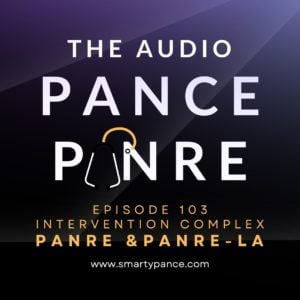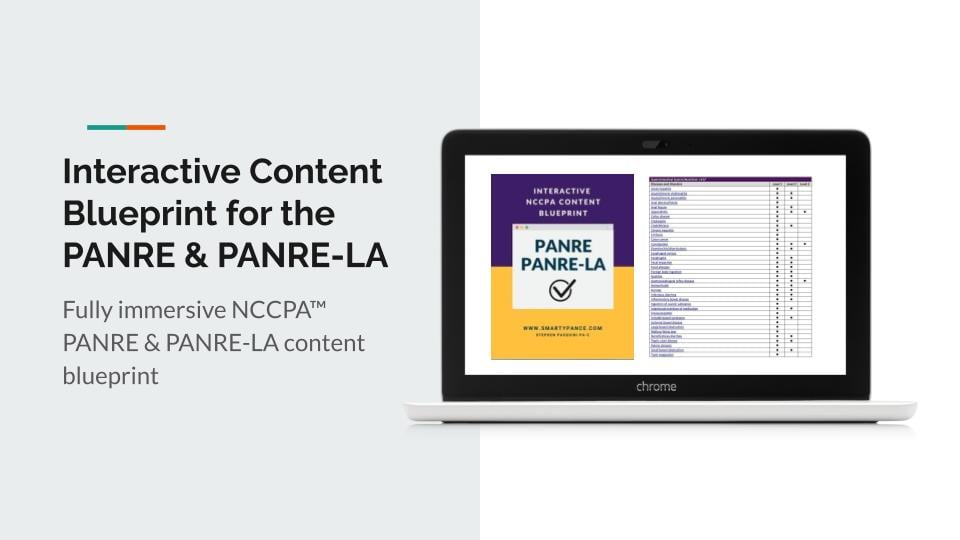Podcast: Play in new window | Download
Subscribe: Apple Podcasts | RSS
Listen to Podcast Episode 103: Ten PANRE & PANRE-LA Intervention Complex Practice Question
If you can’t see the audio player, click here to listen to the full episode.
 Welcome to episode 103 of the Audio PANCE and PANRE Physician Assistant/Associate Board Review Podcast.
Welcome to episode 103 of the Audio PANCE and PANRE Physician Assistant/Associate Board Review Podcast.
Join me today as we cover ten NCCPA-style board review questions for your PANRE and PANRE-LA exams.
Special from today’s episode:
- Take the new PANRE & PANRE-LA (Intervention Complex) Practice Exam: Covers all the topics tested within the new PANRE (Intervention Complex) performance expectation with links to Smarty PANCE lessons.
- PANRE & PANRE-LA Blueprint 8-Week Schedule and Study Planner
- Read The New 2023 PANRE and PANRE-LA: Everything you Need to Know
- Members can try out the newly updated PANRE-LA Smart Search Tool (you must log in to access the search bar)
- Sign up for the Entire Blueprint Email Series to get daily questions for the next 478 days!
- Follow Smarty PANCE and The Daily PANCE Blueprint on Instagram
- Follow Smarty PANCE and The Daily PANCE Blueprint on Facebook
- Join the Smarty PANCE Member’s Community, then sign up for a study group to get updates about upcoming webinars
I hope you enjoy this free audio component of the examination portion of this site. Smarty PANCE includes over 2,000 interactive board review questions, along with flashcards, ReelDx cases, integrated Picmonics, and lessons covering every blueprint topic available to all Smarty PANCE members.
- You can download and listen to past FREE episodes here, on iTunes, Spotify, Google Podcasts, Stitcher, and most podcasting apps.
- You can listen to all the latest episodes, take interactive quizzes, and download more resources on each episode page.
Here is an interactive exam to complement today’s podcast
1. A 65-year-old man presents to your office with complaints of constipation for the past six months. He says that he has difficulty passing stools, which are hard and dry. He also reports occasional abdominal pain and bloating. He denies any weight loss, blood in stools, fever, or night sweats. His medical history is significant for hypertension and type 2 diabetes mellitus. His medications include metformin, lisinopril, and aspirin. He does not smoke or drink alcohol. On physical examination, his vital signs are normal. His abdomen is soft and nontender, with normal bowel sounds. There are no masses or organomegaly palpable. Which of the following is the most appropriate next step in evaluating this patient?
A) Colonoscopy
B) Barium enema
C) Thyroid function tests
D) Stool osmolarity
E) Dietary modification
2. A 60-year-old male presents to the emergency department with chest pain and shortness of breath. ECG reveals ST segment elevation in the anterior leads. Which of the following laboratory tests is the most specific for the diagnosis of acute myocardial infarction (AMI)?
A) Troponin
B) Creatinine kinase-MB (CK-MB)
C) Myoglobin
D) C-reactive protein (CRP)
E) Brain natriuretic peptide (BNP)
3. A 65-year-old woman with a history of atrial fibrillation, hypertension, and obesity presents to the emergency department with acute onset of severe left leg pain and swelling. She has been taking warfarin for anticoagulation but admits to missing some doses in the past week. Her blood pressure is 180/100 mmHg, pulse is 110 beats/min and irregular, and respiratory rate is 20 breaths/min. Her physical examination reveals a warm, tender, erythematous left lower extremity with prominent superficial veins and a positive Homan’s sign. Her international normalized ratio (INR) is 1.5. What is the most appropriate next step in the management of this patient?
A) Start heparin infusion and adjust warfarin dose
B) Order duplex ultrasonography of the lower extremities
C) Administer tissue plasminogen activator (tPA)
D) Perform venography of the left leg
E) Apply compression stockings and elevate the leg
4. A 7-year-old child presents with honey-colored crusting lesions on the face and extremities. The lesions started as small red papules that quickly progressed to vesicles and then ruptured, leaving behind a honey-colored crust. The child has no fever and is otherwise healthy. What is the most appropriate initial treatment for this condition?
A) Topical corticosteroids
B) Oral antihistamines
C) Oral doxycycline
D) Topical mupirocin
E) Oral acyclovir
5. A 72-year-old woman with a history of hypertension, diabetes mellitus, and atrial fibrillation presents to the emergency department with sudden onset of left-sided weakness and slurred speech. She was last seen normal 2 hours ago by her daughter. Her vital signs are: blood pressure 180/100 mmHg, pulse 110 beats/min irregularly irregular, respiratory rate 18 breaths/min, temperature 36.5°C (97.7°F), and oxygen saturation 98% on room air. On physical examination, she has left facial droop, left hemiparesis (4/5 strength), and dysarthria. Her NIH Stroke Scale score is 8. A non-contrast head CT scan shows no evidence of hemorrhage. What is the most appropriate next step in management?
A) Administer intravenous alteplase
B) Administer intravenous heparin
C) Perform carotid endarterectomy
D) Perform mechanical thrombectomy
E) Start oral aspirin
6. A 65-year-old man with a history of hypertension and peptic ulcer disease presents to your clinic for a routine follow-up. He reports feeling well and has no complaints. His medications include lisinopril and omeprazole. His vital signs are normal. A complete blood count (CBC) shows:
- Hemoglobin: 10 g/dL (normal: 13-17 g/dL)
- Hematocrit: 30% (normal: 40-50%)
- Mean corpuscular volume (MCV): 70 fL (normal: 80-100 fL)
- Red cell distribution width (RDW): 18% (normal: 11-15%)
- White blood cell count: 6 x 10^9/L (normal: 4-11 x 10^9/L)
- Platelet count: 250 x 10^9/L (normal: 150-450 x 10^9/L)
What is the most likely cause of this patient’s anemia?
A) Chronic kidney disease
B) Folate deficiency
C) Gastrointestinal bleeding
D) Thalassemia trait
E) Vitamin B12 deficiency
7. A 42-year-old woman with a history of GERD presents to your clinic for follow-up. She has been taking omeprazole 20 mg daily for the past 6 months and reports significant improvement in her heartburn and regurgitation symptoms. She has also made lifestyle modifications such as avoiding spicy and fatty foods, quitting smoking, and elevating the head of her bed. She asks you if she can stop taking omeprazole or reduce the dose. What is the most appropriate next step in management?
A) Continue omeprazole 20 mg daily indefinitely
B) Discontinue omeprazole and monitor symptoms
C) Switch to famotidine 20 mg twice daily
D) Taper omeprazole to every other day for 4 weeks
E) Perform an upper endoscopy
8. Which of the following is an appropriate step-down therapy for a patient with well-controlled asthma on medium-dose inhaled corticosteroids (ICS) and long-acting beta agonists (LABA)?
A) Discontinue LABA and continue medium-dose ICS
B) Discontinue ICS and continue LABA
C) Reduce ICS dose by 50% and continue LABA
D) Reduce both ICS and LABA doses by 50%
E) Switch to low-dose ICS/formoterol as needed
9. A 35-year-old woman presents to her primary care provider with complaints of chronic worry and nervousness for the past 8 months. She says she worries about everything, such as her health, her family, her work, and her finances. She has difficulty sleeping, concentrating, and relaxing. She also experiences muscle tension, headaches, and palpitations. She denies any history of trauma, substance abuse, or other psychiatric disorders. She has no medical problems and takes no medications. Her vital signs are normal and her physical examination is unremarkable. Which of the following is the most likely diagnosis?
A) Panic disorder
B) Obsessive-compulsive disorder
C) Post-traumatic stress disorder
D) Generalized anxiety disorder
E) Adjustment disorder
10. A 65-year-old man with a history of type 2 diabetes mellitus presents to the emergency department with altered mental status, polyuria, and polydipsia. He has been feeling unwell for the past week with a urinary tract infection that he has been self-treating with cranberry juice. His vital signs are: blood pressure 180/100 mmHg, heart rate 110 beats per minute, respiratory rate 24 breaths per minute, temperature 37.8°C (100°F), and oxygen saturation 95% on room air. His physical examination reveals dry mucous membranes, poor skin turgor, and decreased level of consciousness. His laboratory tests show:
- Serum glucose: 900 mg/dL
- Serum sodium: 150 mEq/L
- Serum potassium: 4.0 mEq/L
- Serum bicarbonate: 18 mEq/L
- Serum osmolality: 350 mOsm/kg
- Urine ketones: negative
Which of the following is the most appropriate initial treatment?
A) Intravenous insulin infusion
B) Intravenous normal saline infusion
C) Intravenous sodium bicarbonate infusion
D) Intravenous potassium chloride infusion
E) Subcutaneous insulin glargine injection
This podcast is available on every device!
You can download and listen to past FREE episodes here, on iTunes, Spotify, Google Podcasts, Stitcher, Amazon Music, and all podcasting apps.
Download Interactive Content Blueprint Checklists for the PANCE, PANRE, EOR, and PANRE-LA
Follow this link to download your FREE copy of the PANCE/PANRE/EOR Content Blueprint Checklists.
Print it up and start crossing out the topics you understand, marking the ones you don’t, and making notes of key terms you should remember. The PDF version is interactive and linked directly to the individual lessons on Smarty PANCE.

